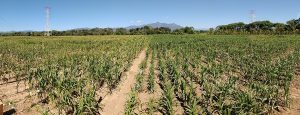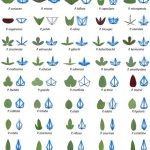Phenomics: from under the gum trees to the world – the 5th International Plant Phenotyping Symposium down under

View towards the National Wine Centre of Australia (conference venue) from the Adelaide Botanic Garden
 Having just attended our first plant phenomics conference – it was great to learn how far the field has progressed and how rapidly it continues to progress with the advancement of new technologies for high-throughput phenotyping. The greater plant phenomics community is trying to collect and define sets of physical and biochemical traits belonging to a given plant species as they adapt in response to genetic mutation and/or environmental influences. The community is trying to find answers to big questions, such as – how will we ensure sustainable farming? How will we feed our growing population? How will crops withstand changing climates? All rather important questions given global warming and the rapid population growth on this planet. And like the genomics community 20 years prior, the plant phenomics community are now faced with challenges, and big questions surrounding the lack of data standardization and management, as well as incentives surrounding data sharing remain – all of which are essential for reproducible research and advancing phenomics research. Below are some highlights from the meeting.
Having just attended our first plant phenomics conference – it was great to learn how far the field has progressed and how rapidly it continues to progress with the advancement of new technologies for high-throughput phenotyping. The greater plant phenomics community is trying to collect and define sets of physical and biochemical traits belonging to a given plant species as they adapt in response to genetic mutation and/or environmental influences. The community is trying to find answers to big questions, such as – how will we ensure sustainable farming? How will we feed our growing population? How will crops withstand changing climates? All rather important questions given global warming and the rapid population growth on this planet. And like the genomics community 20 years prior, the plant phenomics community are now faced with challenges, and big questions surrounding the lack of data standardization and management, as well as incentives surrounding data sharing remain – all of which are essential for reproducible research and advancing phenomics research. Below are some highlights from the meeting.
From Genomes to Phenomes – linking the two

Maize crop, photo courtesy of Rubén Rellán Álvarez.
The 5th International Plant Phenomics Symposium (IPPS, Adelaide, Australia) kicked off with a entertaining keynote by Mark Tester (KAUST, Saudi Arabia), who highlighted that the complexity of phenomics, compared with genomics, is huge. To help tackle this, a global non-profit association – the International Plant Phenotyping Network (IPPN), has been created to integrate the phenomics community around the world. The IPPN includes members from academia and industry and is open to all. He highlighted the key role that genomics has played in turbo-charging genetic research in plants and medicine and now, agriculture – enabling huge opportunities with phenotyping and technological innovation.
Tester presented his group’s work looking at salt tolerance in several plants including rice, tomato, quinoa, and barley. He also highlighted their promising studies on the salt-tolerant tomato, Solanum pimpinellifolium, Barley and Quinoa – involving quantitative field genetics and now creating field plots for trials and drones for phenotyping. Continuing the theme on rice, one important agricultural example is the completion and release of the 3,000 Rice Genomes Project, published in GigaScience. This has enabled the rice agricultural phenotyping community to significantly advance, and we are now seeing groups utilizing the openly available rice genomic data and applying phenomics approaches, such as Large-scale phenomics analysis of a T-DNA tagged mutant population. In his keynote, Rajeev Varshney (ICRISAT) also highlighted the importance of linking genomics to phenomics in order to make the best use of science to enhance the rate of genetic gain. The early release of the Chickpea genomic data in 2014 has led to significant advances in Chickpea genomics and phenomics work.
Hyperspectral imaging involves the collection and processing of pixel information from across the electromagnetic spectrum, with the purpose of finding objects, identifying materials, or detecting processes. In agriculture, such imaging typically means high costs to collect information from crops and specific climates; however, advances in the development of hyperspectral remote sensing via drones has lead to an increase in usage to monitor the development and health of crops. It was great to see a variety of hyperspectral phenomics approaches being presented at the conference. Back to rice, Wennang Yang (Huazhong Agricultural University, China) has been applying such approaches to rice in field and greenhouse to understand the genetic architecture of drought-resistant rice. Trevor Garnett (APPF) has been applying hyperspectral approaches to analyze nutrients – combining the imaging data with high-throughput growth analysis to understand nitrogen response in wheat.
Embracing informatics and computational approaches
An increasing number of groups are starting to embrace informatics and computational approaches to analyze high-throughput big phenomics data – presenting an exciting time for the phenomics community. Being able to integrate genomics, genetics and phenomics are important to shed new light. however, this can only be achieved through better sharing and reuse of data. An enthusiastic researcher, Clayton Carley (Iowa State), presented his efforts on using machine learning to solve a phenomics challenge in soybeans, with his tool, SNAP (Soybean Nodule Acquisition Program). SNAP combines deep learning, convolutional networks, and machine learning. His goal is to count soybean nodules in a more efficient and reproducible way to quantify the life-cycle of nodules.
 Being fans of the open science techy sorts, Daniel Arend (IPK Gatersleben) presented the PGP Database (Plant Genomics and Phenomics Research Data Repository) and their efforts for data storage, management and dissemination. Arend highlighted that plant research data is very heterogeneous and existing databases are very specialized – so there’s a need for broad scope databases. GigaScience author, Dan Chitwood, also highlights such issues in an author Q&A. Arend stressed the importance of data sharing and highlighted how the PGP complies with the FAIR (Findable, Accessible, Interoperable and Reproducible) Data principles. It was nice to see GigaScience Data Notes being highlighted as a way to publish large-scale datasets in our open and FAIR repository, GigaDB, and get more credit for doing so by our citable DOIs. You can read more about how FAIRly easy it is to practice open science and the benefits for the researcher and the community in our blog.
Being fans of the open science techy sorts, Daniel Arend (IPK Gatersleben) presented the PGP Database (Plant Genomics and Phenomics Research Data Repository) and their efforts for data storage, management and dissemination. Arend highlighted that plant research data is very heterogeneous and existing databases are very specialized – so there’s a need for broad scope databases. GigaScience author, Dan Chitwood, also highlights such issues in an author Q&A. Arend stressed the importance of data sharing and highlighted how the PGP complies with the FAIR (Findable, Accessible, Interoperable and Reproducible) Data principles. It was nice to see GigaScience Data Notes being highlighted as a way to publish large-scale datasets in our open and FAIR repository, GigaDB, and get more credit for doing so by our citable DOIs. You can read more about how FAIRly easy it is to practice open science and the benefits for the researcher and the community in our blog.
From data storage and management to analysis tools – Lorenc Cabrera-Bosquet (INRA), presented the open source PHIS ontology-driven information system for plant phenomics, that handles multi-scale and multi-source information and helps with the data management complexity of plant phenomics data. Tim Brown (Australian Plant Phenotyping Facility, APPF), gave an insightful talk highlighting the need for SCAP – scalable architecture for collaborative phenomics. Technological advances now means we can measure “everything”; however, the phenomics field lacks effective tools to make full use of the data. Brown presented several open source tools the APPF is currently working on, including SCAP – a organization structure for creation, analysis and sharing of phenomics datasets, pipelines and visualization software and the need for open community data standards for interoperability, better data storage, and full access, and the need for open-source, low-cost, easy-to-use high-throughput systems for general research.
Data sharing and standardization – a need for change
The need for data sharing and standards were continuing themes at the conference and this was clearly highlighted during the Data Management discussion panel. However, the most important reason about why to share data – reproducibility – was briefly mentioned, by panel contributor, Carolyn Lawrence-Dill (Iowa State University). Given the great complexity of phenomics data, standardization across the community remains to be a challenge, and numerous working groups in the IPPN have formed, including a Data Management working group. There is certainly the motivation to figure out how data standard across the field might look like and we look forward to reading more updates about that soon.
GigaScience – helping to disseminate and integrate the data
 As advocates for open science, we continue and cannot emphasize enough how important data sharing and reproducible research is. Data gathering is expensive both in time and money – given the length of time of experiments to gather phenomics data, the community would greatly benefit from sharing data to replicate validate and enhance scientific discovery in the field.
As advocates for open science, we continue and cannot emphasize enough how important data sharing and reproducible research is. Data gathering is expensive both in time and money – given the length of time of experiments to gather phenomics data, the community would greatly benefit from sharing data to replicate validate and enhance scientific discovery in the field.
To help the plant phenomics community to disseminate their multi-scale, heterogenous, large datasets, GigaScience has an open thematic series “Plant Phenomics – Data Integration and Analyses”, Guest Edited by Rubén Rellán Álvarez, Guillaume Lobet, Malia Gehan, and Srikant Srinivasan.
 We continue to encourage the submission of Research Articles and Technical Notes, as well as more Data Notes, which are perfect for focussing on the description of interesting plant phenomic datasets, curated and hosted in our database, GigaDB. We also consider Commentaries and thought-provoking Reviews in this area, so feel free to suggest topics and ideas to us.
We continue to encourage the submission of Research Articles and Technical Notes, as well as more Data Notes, which are perfect for focussing on the description of interesting plant phenomic datasets, curated and hosted in our database, GigaDB. We also consider Commentaries and thought-provoking Reviews in this area, so feel free to suggest topics and ideas to us.
Potential topics covered by the series include, but are not limited to:
- New methods in phenotype data collection e.g. Drones, imaging techniques
- New tools in phenotype data integration and analyses
- Morphometrics
- Organ-scale phenomics
- Databases, management and workflows
- Research or Data wrapped in a virtualized or containerized form e.g. Docker, Singularity, etc.
You can submit your manuscript using GigaScience’s online submission system. Please, state clearly in your covering letter that it is intended for the Plant Phenomics thematic series. For further questions, please contact us at editorial@gigasciencejournal.com.